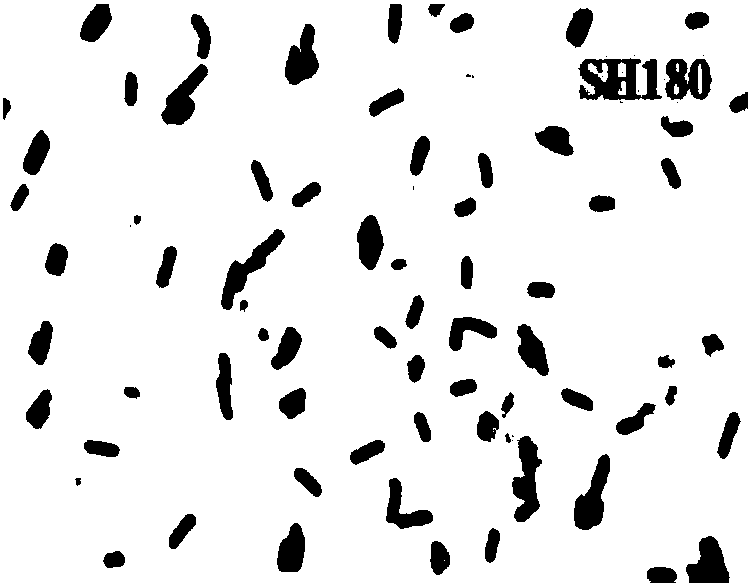Bacillus safensis for producing protease and resisting botrytis cinerea and application thereof
A technology of bacillus and bacterial strains, which is applied in the application field of Bacillus suffolus SH180 and its protease production and resistance to tomato gray mold, which can solve the problems of few reports of bacillus, achieve the effect of inhibiting gray mold disease and promoting tomato growth
- Summary
- Abstract
- Description
- Claims
- Application Information
AI Technical Summary
Problems solved by technology
Method used
Image
Examples
preparation example Construction
[0036] In yet another specific embodiment of the present invention, a method for preparing growth-promoting bacteria fermentation liquid is provided, the steps are as follows: transfer Bacillus safensis SH180 to a test tube with 5ml liquid medium, put Cultivate in a constant temperature shaker for 12-14h, temperature: 37°C, speed: 180-200rpm; insert the activated bacterial solution into 100-200mL medium according to the inoculum amount of 1%, put it into the shaker for 24h, temperature : 37°C, rotating speed: 180-200rpm, make fermentation broth.
[0037] In yet another specific embodiment of the present invention, a method for using the above growth-promoting bacterium fermentation liquid is provided. After the tomato seedlings are settled, the prepared fermentation liquid is diluted and then root-irrigated. In the pot test, each plant is 5 mL.
[0038] In yet another specific embodiment of the present invention, a pharmaceutical composition is provided, which is characterized...
Embodiment 1
[0040] Example 1 Determination of SH180's ability to promote plant growth
[0041] The CK strain was selected as the control, and the experiment was carried out in natural soil by planting in nutrient trays. It was cultivated in the seedling medium until 5-6 true leaves were grown, and healthy and uniform tomato seedlings were selected for use. Treat the tomato seedlings by filling the roots, the method is as follows: After transplanting the seedlings, wait for the growth of the seedlings to stabilize, and treat 5 seedlings (1 strain / pot) with the bacterial agent after 7 days, and apply 5 mL of growth-promoting bacteria fermentation liquid (concentration is about 10 8 cfu / mL), watered around the root system after appropriate dilution, and managed normally; the control was the culture solution of CK strain. After 40 days, the plant height, ground diameter and root length of the plants were measured. The comparison results are shown in Table 1 and Figure 4 shown.
[0042] Ta...
Embodiment 2
[0045] Example 2 Determination of SH180 Protein Production Ability
[0046] The determination adopts the Folin phenol method. Add 1 mL of the original fermentation broth plus 2 mL of casein solution with a mass fraction of 0.5% at a pH value of 7.0, bathe in water at 37°C for 15 minutes, then inactivate with 10% trichloroacetic acid, and then take 1 mL Add 1 mL of Folin phenol and 5 mL of 0.55 mol / L Na to the centrifuged supernatant of the above reaction liquid 2 CO 3 , in a water bath at 37°C for 15 minutes, and measure the absorbance value at 660nm. The reaction system with inactivated enzyme solution was used as the blank control. Under this reaction condition, it is defined that the amount of enzyme needed to generate 1 μg of tyrosine per 1 min is one enzyme activity. The effect of protease production is as image 3 shown.
[0047] The protease detection results are shown in Table 2 below:
[0048] Table 2 produces protease detection results
[0049]
PUM
 Login to View More
Login to View More Abstract
Description
Claims
Application Information
 Login to View More
Login to View More - R&D
- Intellectual Property
- Life Sciences
- Materials
- Tech Scout
- Unparalleled Data Quality
- Higher Quality Content
- 60% Fewer Hallucinations
Browse by: Latest US Patents, China's latest patents, Technical Efficacy Thesaurus, Application Domain, Technology Topic, Popular Technical Reports.
© 2025 PatSnap. All rights reserved.Legal|Privacy policy|Modern Slavery Act Transparency Statement|Sitemap|About US| Contact US: help@patsnap.com



